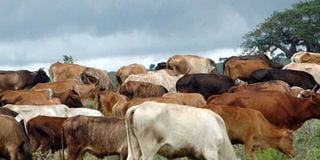Surveillance system boosts efforts to tame Rift Valley Fever

Rift Valley Fever is one of the diseases that can break out during heavy rains and flooding, but Kenya seems to be taking the necessary steps to deal with it. PHOTO | FILE
Rift Valley Fever is one of the diseases that can break out during heavy rains and flooding, but Kenya seems to be taking the necessary steps to deal with it.
A study by researchers from Kenyan and other international research institutions published in PLOS Neglected Tropical Disease in April, announced an enhanced national surveillance system that tracks symptoms in livestock as noted by farmers and sub-county veterinary officers, who then report to an alert centre that receives, compiles and reports data from 22 high-risk counties on a weekly basis. Rift Valley Fever (RVF) is a zoonosis, a viral disease that primarily affects animals but can also infect humans. It is spread to livestock by Aedes mosquitoes.
People get infected when they come into contact with the blood of infected animals through slaughtering, eating, assisting in animal births, and disposal of carcasses of animals that had RVF. Most infected humans experience mild flu-like symptoms which could be mistaken for malaria or dengue fever, while less than one per cent bleed from all openings or go blind.
RVF was first isolated in Kenya’s Rift Valley in 1931 and has caused farmers losses through abortions and deaths of livestock. In a 2006/2007 outbreak, Kenya incurred Sh32 million in losses from the disease. A 2016 report titled From Panic and Neglect to Investing in Health Security observed that Kenya was not prepared to handle a pandemic, citing failure to take the necessary steps to withstand an attack.
Without a surveillance system, farmers did not have routine check-ups for their animals and only took them to veterinary officers when they fell sick. Moreover, veterinary service coverage was scanty and the government had stopped employing veterinarians in the 1990s. Judging how fast the disease would be transmitted, medical anthropologist Dr Salome Bukachi found that cultural values attached to raw meat and blood took precedence over the fear of getting sick in communities that kept livestock.
Her study in Ijara in Garissa County, found that sheep fat which was used for cooking, treating pneumonia, stomach discomfort, typhoid and wounds, and raw blood, was consumed by women to replenish blood lost during delivery and to cure stomach ailments.
These factors, and the lack of alternative sources of food from animals, made the communities resign to eating meat from potentially infected animals, while praying that God would protect them from illness. Moreover, political neglect of the north-eastern region left residents at the mercy of an outbreak without veterinary and medical assistance.



